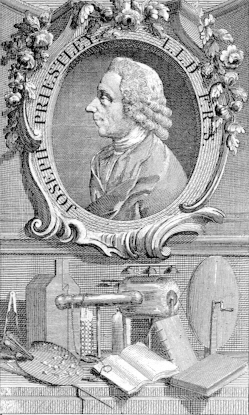Today, let's ask who discovered oxygen. The University of Houston's College of Engineering presents this series about the machines that make our civilization run, and the people whose ingenuity created them.
In the mid 18th century, people thought air was inert -- that it didn't take part in combustion. We know that the oxygen in air reacts with other materials when they burn. But 18th-century chemists thought burning materials were simply releasing an invisible fluid called phlogiston, which caused heating. No one supposed burning had anything to do with the air itself. They didn't know the culprit was oxygen, which makes up one fifth of air.
Oxygen was finally pinned down as a separate element by three people in the 1770s: an English cleric named Priestley; the French chemist Lavoisier; and a Swedish pharmacist named Scheele.
Priestley isolated oxygen in 1774, but he thought he had laughing gas. A year later he decided he'd actually taken the phlogiston out of air. At the same time, Lavoisier (who knew about Priestley's work) also isolated oxygen. He took it to be very pure air.
Two years later, Lavoisier realized that he'd actually separated a component of air; but he thought it came into existence only when the air was heated. Meanwhile, the Swede, Scheele, had been working quietly. He published a book called Air and Fire just after Lavoisier's final word on the matter. In it, he identified oxygen as a separate part of air, based on work he'd done before either Priestley or Lavoisier.
Historian Thomas Kuhn uses this muddle to explain a problem that bedevils scientific discovery. Squabbles over credit cloud the real nature of discoveries. Should we credit Priestley, who isolated oxygen and then went to his death thinking it was something else? Should we credit Lavoisier, who saw it was part of air, but didn't understand its nature? And what about Scheele, who published his work after that part of the game was over?
The fact is that oxygen couldn't really be understood until scientists changed their whole view of matter. Priestley started a scientific revolution that wouldn't be finished until John Dalton built oxygen into the atomic theory of matter -- thirty years later. The idea that burning meant new combinations of atoms was too great a leap for any one person to make. The pieces of the puzzle added up, and added up, until suddenly an unexpected new picture came clear.
Oxygen wasn't just discovered. Oxygen as we understand it today couldn't have been discovered in 1770. Instead, a whole new science had to be forged to accommodate it. Priestley, Lavoisier, Scheele, Dalton -- each added new insights that finally forced a major scientific revolution.
I'm John Lienhard, at the University of Houston, where we're interested in the way inventive minds work.
(Theme music)
Kuhn T., The Structures of Scientific Revolutions. 2nd ed. Chicago: University of Chicago Press, 1970.
This episode has been greatly revised as Episode 1515.

(From Dibner, B., Early Electrical Machines.
Image courtesy of the Burndy Library, Dibner Institute for the History of Science and Technology)
Joseph Priestley